Cultural and Historical Symbols
Exploring Crosses and Their Meanings in Depth
Uncover the diverse cultural and spiritual significance of crosses and their meanings, from ancient symbols to modern religious iconography.
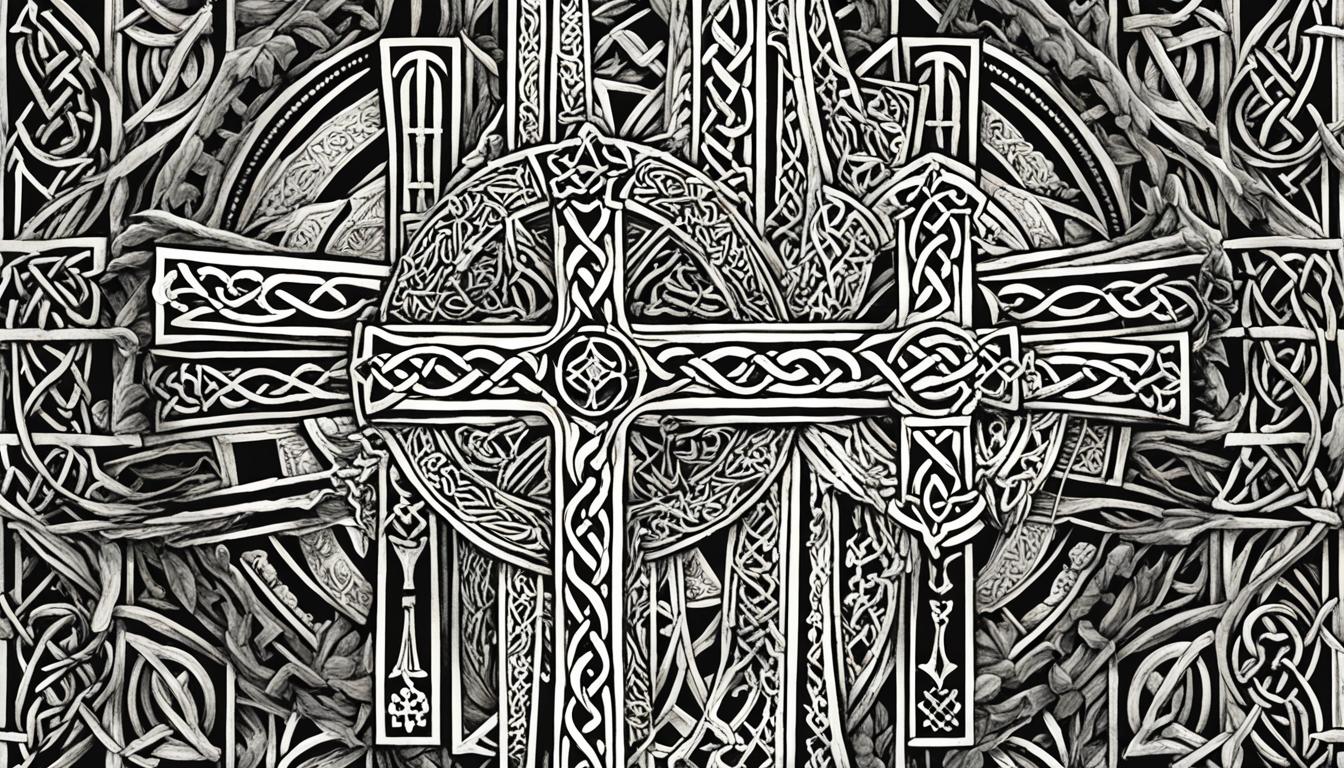
Did you know that crosses have been used as symbols for thousands of years, spanning a wide range of cultures and religions? These powerful religious symbols hold deep significance and have diverse meanings associated with them.
In this article, we will delve into the cultural and spiritual significance of crosses and their meanings. We will explore the ancient symbols and modern religious iconography related to crosses, highlighting the deep religious symbolism and the various interpretations of this powerful symbol.
Key Takeaways:
- Crosses have been used as symbols for thousands of years in various cultures and religions.
- Crosses hold deep cultural and spiritual significance.
- There are diverse meanings associated with crosses, ranging from sacrifice and transcendence to love and heroism.
- Understanding the symbolism of crosses can provide insights into religious traditions and deepen our understanding of various cultures.
- We will explore different types of crosses, their designs, and their cultural interpretations.
The Cross: A Symbol Transcending Time and Culture
The cross is an ancient symbol that has transcended time and culture, holding profound significance throughout human history. Dating back to pre-Christian times, the cross has been found in ancient cave art, showcasing its enduring presence and universal appeal. This section will explore the diverse types of crosses, cultural interpretations of their meaning, and the rich history of cross symbolism.
Types of Crosses
There are numerous types of crosses, each with its own unique design and symbolism. Let’s take a closer look at a few of the most well-known types:
| Type of Cross | Description | Symbolism |
|---|---|---|
| Latin Cross | A simple upright cross with a shorter horizontal beam near the top. | A symbol of Christianity and Christ’s sacrifice. |
| Celtic Cross | A cross with a circle intersecting the vertical and horizontal beams. | Combines Christian and Celtic traditions, representing eternal life and the intersection of the physical and spiritual realms. |
| Coptic Cross | A cross with a loop at the top, resembling an ankh cross. | A symbol of the Coptic Orthodox Church and the union of divinity and humanity in Christ. |
These are just a few examples of the diverse range of cross designs and their cultural interpretations. The significance of crosses extends far beyond their visual representation, encompassing religious, spiritual, and symbolic connotations.
Cultural Interpretations of Crosses
“The cross has a multitude of meanings across different cultures and traditions. It serves as a powerful symbol that bridges the gap between the earthly and spiritual realms.”
Throughout history, the cross has been interpreted in various ways by different cultures and religious traditions. In Christianity, it represents the crucifixion and resurrection of Jesus Christ, embodying themes of sacrifice, redemption, and eternal life. In other cultures, the cross has been associated with concepts such as fertility, the sun, and the four elements.
An example of cultural interpretation can be observed in ancient Egyptian hieroglyphs, which depict the “ankh” symbol resembling a cross with a loop at the top. The ankh symbolized life and immortality in the Egyptian belief system, illustrating how crosses can hold different meanings and interpretations in diverse cultural contexts.
History of Cross Symbolism
“The history of cross symbolism dates back thousands of years, with evidence of its presence in various ancient civilizations and religious practices.”
The cross’s symbolism predates Christianity and can be traced back to prehistoric times. It has been found in rock art and artifacts dating back thousands of years, showcasing its enduring presence in human consciousness. In ancient civilizations such as the Aztecs, Mayans, and Greeks, crosses held cultural, religious, and spiritual significance.
One of the most well-known historical uses of the cross is the Roman crucifixion, a form of execution that involved the victim being nailed to a cross-shaped structure. This method of punishment emphasizes the cross’s association with suffering, sacrifice, and martyrdom.
Furthermore, the cross became an important symbol in the spread of Christianity, as it represented the transformative power of Jesus Christ’s death and resurrection. Over time, the cross developed into a central motif in Christian art, architecture, and religious iconography.
The Transcendent Power of the Cross
“Regardless of cultural interpretations or historical contexts, the cross remains a symbol that transcends time and culture, resonating with people across different faiths and backgrounds.”
Whether it’s the Latin cross in Christianity, the ankh in ancient Egypt, or other cross variations, the symbol continues to evoke powerful emotions and spiritual connections. It represents a bridge between the mundane and the divine, serving as a reminder of our shared human experience and the possibility of transformation.
As we explore the significance of crosses in different cultures and throughout history, we gain a deeper understanding of the diverse interpretations and meanings associated with this timeless symbol.
The Cross as a Point of Transcendence
The cross, a powerful symbol deeply ingrained in human history, holds spiritual meanings that reach beyond the physical realm. It represents a point of transcendence between the earthly plane and spiritual/mystical experience. In exploring the spiritual significance of crosses, we uncover a tapestry of diverse interpretations and symbolisms.
Throughout history, cross designs have evolved and manifested across various cultures and religious traditions. The intricacies of cross iconography serve to amplify its transcendental message.
Cross Designs: A Reflection of Spiritual Meanings
There is an array of cross designs, each weaving its own narrative of spirituality and belief. Let us delve into a few notable examples:
| Cross Design | Spiritual Meaning |
|---|---|
| Latin Cross | The most universally recognized cross design, the Latin cross symbolizes the crucifixion of Jesus Christ and the redemptive power of sacrifice in Christianity. |
| Celtic Cross | Combining a traditional cross with a circular ring, the Celtic cross represents the union of the Christian cross with ancient Celtic symbolism, emphasizing the eternal nature of spirituality. |
| Coptic Cross | Hailing from the Coptic Orthodox Church, the Coptic cross showcases a unique design with intricate details and flourishes, signifying the Copts’ rich spiritual heritage. |
The diverse array of cross designs exemplifies the deep connection between form and meaning, as well as the cultural and historical contexts that shape their interpretations.
Interpreting Cross Iconography
Within cross iconography lies a rich tapestry of layered symbolism, encompassing both universal and culturally specific interpretations. The utilization of various elements within cross designs conveys complex narratives:
- The use of colors: Different hues carry symbolic weight, such as red representing sacrifice or purity, blue symbolizing divinity or heavenly realms, and gold embodying divine light or transcendence.
- Decorative embellishments: Intricate patterns, filigree, or gemstone accents add depth to cross iconography, symbolizing the beauty and richness of the spiritual experience.
- Religious figures and motifs: Depictions of saints, angels, or religious scenes serve as visual representations of divine presence and spiritual guidance.
These elements, integrated harmoniously within cross iconography, invite individuals to reflect on and connect with their own spiritual journeys.
The cross, in its myriad designs and iconography, serves as a powerful catalyst for spiritual contemplation, guiding individuals towards higher states of consciousness and connection with the divine.
As we explore the spiritual meanings of crosses and delve into the intricacies of cross designs and iconography, we gain a deeper understanding of the universal human longing for transcendence.
The Cross as a Symbol of Sacrifice
The cross is widely recognized as a symbol of sacrifice, particularly within the context of Christianity. It holds profound religious significance as a representation of Christ’s ultimate sacrifice for humanity. The cross represents not only the physical crucifixion but also the spiritual and emotional endurance of suffering in pursuit of a greater purpose.
Throughout history, the cross has been used as a powerful visual tool to convey the concept of sacrifice. Its universal recognition as a symbol of Christianity amplifies its impact and deepens its religious connotations. The cross is a constant reminder of the selflessness and devotion required to overcome adversity and fulfill one’s higher calling.
The Cross and Its Representation of Christ’s Sacrifice
At the core of Christianity lies the belief in Jesus Christ’s sacrificial act of giving his life on the cross for the redemption of humanity’s sins. The crucifixion represents the ultimate expression of love, mercy, and sacrifice. Through his willing acceptance of suffering, Jesus demonstrated that his love knew no limits.
The cross serves as a poignant reminder of the magnitude of Christ’s sacrifice, inspiring believers to emulate his example in their own lives. It symbolizes the selflessness and dedication required to follow a path of righteousness despite the challenges and hardships faced along the way.
Moreover, the cross is also a tangible representation of the immense love and compassion that God has for humanity. Through the sacrifice of his son, God offers forgiveness, salvation, and eternal life to those who have faith.
As a religious symbol, the cross holds great reverence and serves as a focal point for worship and reflection. It serves as a visual reminder of the divine sacrifice that underpins the Christian faith and encourages believers to live lives of sacrifice, service, and devotion to God and others.
“The cross, representing Christ’s sacrifice, stands as a symbol of the love and compassion that God has for humanity.”
Throughout history, the cross has been employed as a powerful visual symbol in religious art, expressions of devotion, and the ornamentation of religious spaces. It is a constant reminder of the importance of sacrifice in the spiritual journey and the unwavering commitment required to follow one’s faith.
| Cross Symbolism | Significance |
|---|---|
| Cross Represent | The cross represents the sacrifice of Jesus Christ and the love and compassion of God for humanity. |
| Symbol of Christianity | The cross is the central symbol of Christianity, signifying the core beliefs of the faith and serving as a visual representation of Christ’s sacrifice. |
| Cross Used | The cross is widely used in religious rituals, artwork, and religious adornments to symbolize sacrifice and invoke spiritual contemplation. |
| Cross Is Also | In addition to its religious symbolism, the cross is also recognized as a cultural and historical symbol, representing various aspects of human history, art, and social movements. |
| Religious Symbol | As a religious symbol, the cross holds immense significance and serves as a visual representation of faith, sacrifice, and redemption. |
The Cross as a Model of Love and Heroism
The cross, with its historical and cultural significance, serves as a recognized symbol of love and heroism. Throughout history, there have been numerous remarkable individuals who have embodied these qualities, standing for truth, justice, and love, even in the face of adversity. Among these historical figures, Socrates, Gandhi, and Martin Luther King Jr. stand out as exemplars of love and heroism.
Socrates, the renowned Greek philosopher, fearlessly challenged societal norms and the status quo in his pursuit of truth and wisdom. He believed that love of wisdom, or philosophy, was the highest expression of human potential. Despite facing opposition and ultimately being sentenced to death, Socrates willingly made the ultimate sacrifice, remaining steadfast in his commitment to truth and the pursuit of knowledge.
Gandhi, the influential Indian leader, used nonviolent resistance as a means to fight against injustice and oppression. He advocated for love, tolerance, and harmony among individuals and communities. Gandhi’s dedication to truth, peace, and the welfare of others inspired a nation and continues to resonate with people around the world. His relentless pursuit of justice and his unwavering commitment to love and nonviolence make him a true hero.
“Darkness cannot drive out darkness; only light can do that. Hate cannot drive out hate; only love can do that.” – Martin Luther King Jr.
Martin Luther King Jr. was a prominent figure in the American Civil Rights Movement. In his pursuit of racial equality, he preached love, peace, and nonviolent resistance as powerful tools for social change. King’s famous “I Have a Dream” speech continues to inspire generations, reminding us of the transformative power of love and justice. Despite facing adversity and ultimately sacrificing his life for the cause, King’s legacy of love, heroism, and unwavering commitment to the principles of equality and justice continue to inspire people worldwide.
These historical figures, among countless others, have recognized the transformative power of love and the importance of standing up for what is right, even in the face of tremendous challenges. Their actions serve as a testament to the enduring symbol of the cross, which has become synonymous with love and heroism.
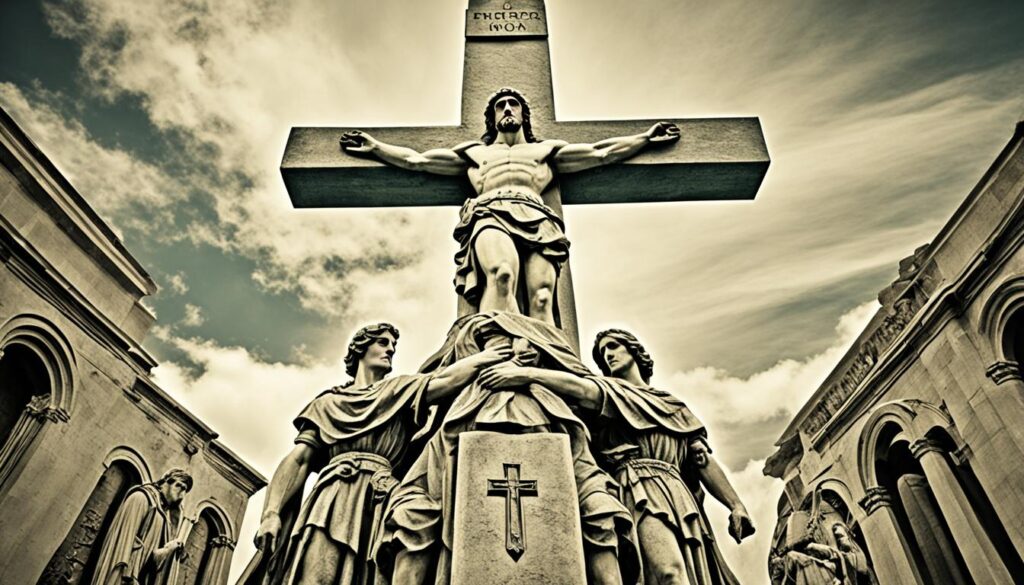
The Upside-Down Cross: Controversy and Symbolism
The upside-down cross, also known as the Petrine Cross, holds both controversy and deep spiritual significance. This unique cross is associated with Saint Peter, a prominent figure in Christian history who requested to be crucified upside-down.
Saint Peter’s decision to be crucified in this manner was a reflection of his humility and sense of unworthiness in comparison to Jesus Christ, who was crucified on an upright cross. By choosing this unconventional form of crucifixion, Saint Peter sought to demonstrate his unworthiness of the same death as Jesus, considering himself a lesser figure in religious authority.
“Lay all the world’s religions before me, and the one I would select would be that of Saint Peter, who knew how to bear the reproach of the cross better than any other.” – Johann Wolfgang von Goethe
The upside-down cross has garnered various interpretations and stirred controversy over the centuries. Some view it as a symbol of Satanic worship or anti-Christian sentiment, perceiving it as a tool of rebellion against religious authority. However, it is crucial to understand that the upside-down cross’s true meaning lies in its association with Saint Peter and his humility, rather than any negative connotations.
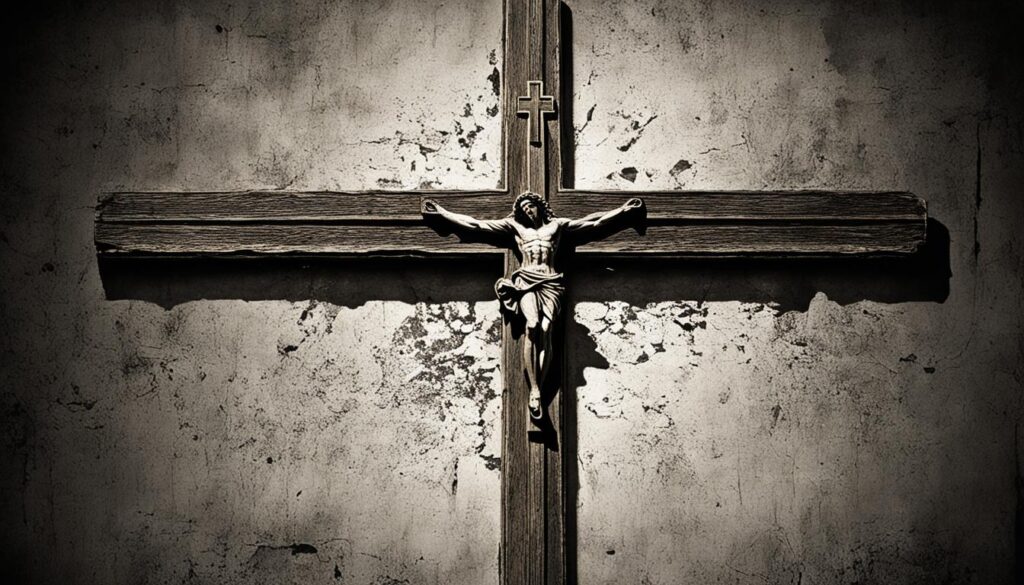
The upside-down cross is often used as a representation of religious authority, challenging conventional norms and highlighting the complexities of faith. It serves as a reminder that religious figures are also human, capable of doubt and imperfection, despite their spiritual authority.
While the traditional, upright cross is widely recognized and symbolizes the sacrifice of Jesus, the upside-down cross represents Saint Peter’s unique journey and his refusal to consider himself equal to Christ. It underscores the extraordinary level of devotion and humility exhibited by this revered apostle.
The Cross as a Symbol of Humility in Christianity
Within Christianity, the cross holds great religious significance, representing a powerful symbol of humility and the acknowledgment of one’s unworthiness before God. It serves as a reminder of Jesus’ sacrifice and the ultimate act of humility demonstrated through his crucifixion.
Throughout the Bible, humility is esteemed as a virtue that Christians should embrace in their lives. Jesus himself set an example of humility through his teachings and actions, emphasizing the importance of putting others before oneself. In Philippians 2:8, it is written, “And being found in human form, he humbled himself by becoming obedient to the point of death, even death on a cross.” This passage highlights the profound humility embodied by Jesus, willingly sacrificing his life for the salvation of humanity.
As the central symbol of Christianity, the cross serves as a visual representation of this humility. Its simple yet powerful design serves as a constant reminder for believers to humble themselves before God and to treat others with kindness and compassion.
“True humility is not thinking less of yourself; it is thinking of yourself less,” said C.S. Lewis, a renowned Christian author and theologian.
The Papacy, as the spiritual leadership of the Roman Catholic Church, has a significant connection to the cross and humility. The Pope, as the head of the Catholic Church, is seen as the successor of Saint Peter, who himself requested to be crucified upside-down, deeming himself unworthy of the same death as Jesus. Saint Peter’s humility and unwavering faith have become synonymous with the Papacy, and the cross serves as a powerful symbol of this humility within the highest authority of the Catholic Church.
By embracing the symbolism of the cross and striving for humility, Christians are reminded of their human limitations and their dependence on a higher power. It calls for genuine introspection and self-reflection, encouraging individuals to humbly submit themselves to God’s will and to live lives marked by humility, compassion, and service to others.

| Papacy and Humility | Key Features | |
|---|---|---|
| 1 | Connection to Saint Peter | The Papacy traces its spiritual authority and lineage back to Saint Peter, who demonstrated humility through his request to be crucified upside-down. This association with humility is symbolized by the cross. |
| 2 | Leadership Example | The Pope, as the leader of the Catholic Church, is seen as an embodiment of humility in his role. His actions and teachings are expected to reflect the humility represented by the cross. |
| 3 | Spiritual Guidance | The cross serves as a reminder for the Pope and all members of the clergy to approach their roles with humility, recognizing their duty to serve and guide believers. |
Overall, the cross holds profound religious significance within Christianity, serving as a symbol of humility and the acknowledgement of one’s unworthiness before God. It represents the ultimate act of sacrifice and calls believers to live lives marked by humility, recognizing the importance of putting others before oneself. The connection between the cross and the Papacy underscores the significance of humility within the highest authority of the Catholic Church, symbolizing the ongoing importance of this virtue within the Christian faith.
Misinterpretations and Misconceptions of the Cross
Despite its sacred origins, the cross has been subjected to numerous misinterpretations and misconceptions throughout history. These misunderstandings often stem from a lack of understanding or intentional misrepresentation of its true meaning. One common misconception is the association of the cross with satanism, which is a misinterpretation of its deep religious significance. It is important to clarify these misconceptions and shed light on the complexities of religious symbols in popular culture.
Addressing Misconceptions
One of the most prevalent misconceptions surrounding the cross is its connection to satanism. Some individuals wrongly assume that the cross symbolizes rebellion against religious authority or anti-Christian sentiment. However, this interpretation is far from the truth. The cross holds a central place in Christianity and represents the ultimate sacrifice and love of Jesus Christ. It is a symbol of faith, not an emblem of satanic worship.
Another misconception is the belief that the cross has a universally negative connotation. While it is true that the cross has been used in various historical contexts as a symbol of oppression or persecution, it is essential to understand that these negative associations are not inherent to the symbol itself. The cross should be viewed in its religious and cultural context to fully appreciate its intended meaning.
Complexities of Religious Symbols
“Symbols are not always what they seem. The true meaning lies beneath the surface, awaiting discovery.”
Religious symbols, including the cross, are intricate and multifaceted. They have the power to evoke deep emotions and represent complex beliefs and traditions. However, symbols are often subject to interpretation and can be misunderstood or misused. It is crucial to approach religious symbols with an open mind, willing to explore their historical and cultural significance.
The cross, in particular, carries different meanings across various religious and cultural contexts. It is a symbol of salvation and love in Christianity, while in other faiths and traditions, it may represent sacrifice, balance, or connection with the divine. Understanding these diverse interpretations helps dispel misconceptions and fosters greater respect for religious symbols.
| Common Misconceptions | Factual Explanation |
|---|---|
| The cross is a symbol of satanism. | The cross is a central symbol in Christianity and represents the ultimate sacrifice of Jesus Christ. It has no inherent connection to satanism. |
| The cross symbolizes rebellion against religious authority. | The cross is a symbol of faith and love in Christianity. It is not intended as a representation of rebellion. |
| The cross has a universally negative connotation. | The cross’s meaning varies across different religious and cultural contexts. Negative associations are not inherent to the symbol itself. |
Examining these misconceptions and understanding the complexities of religious symbols like the cross enables us to appreciate the true depth and significance they hold. By seeking knowledge and embracing cultural diversity, we can foster a more inclusive and informed understanding of religious symbols in popular culture.
Different Types of Crosses and Their Meanings
The cross is a symbol that takes various forms, each with its own unique design and cultural significance. In this section, we will delve into the meanings associated with three popular types of crosses: the Latin cross, Celtic cross, and Coptic cross.
The Latin Cross
The Latin cross is one of the most recognized symbols of Christianity. It consists of a vertical line intersected by a shorter horizontal line near the top. Also known as the Christian cross or the Western cross, the Latin cross is widely used in religious contexts and represents the crucifixion of Jesus Christ.
“The Latin cross serves as a powerful reminder of Christ’s sacrifice and the redemption offered through his death and resurrection.” – Christian Theologian
The symbolism of the Latin cross extends beyond its religious significance. It has also become a universal symbol of hope, faith, and love, embraced by people of various cultures and backgrounds.
The Celtic Cross
The Celtic cross is a cross with a circle intersecting the crossbar. It originated from Celtic culture and is associated with pre-Christian spirituality in Ireland, Scotland, and other Celtic regions. The circle represents the cycle of life, eternity, and the sun, while the cross represents the intersection of the physical and spiritual realms.
“The Celtic cross embodies the harmony between the celestial and earthly realms, serving as a symbol of balance, protection, and spiritual connection.” – Celtic historian
The Celtic cross is often adorned with intricate knotwork and other Celtic designs, reflecting the rich artistic traditions of the Celtic people. It is commonly found in Celtic art, jewelry, and as gravestones in ancient cemeteries.
The Coptic Cross
The Coptic cross is an ancient Christian cross variant used by the Coptic Orthodox Church of Alexandria, Egypt. It features a unique design with a crossbar at the top pointing to heaven and a lower crossbar symbolizing the earthly realm. The cross is often encompassed by a circle representing God’s eternal love and protection.
“The Coptic cross symbolizes the unity of heaven and earth and the eternal love of God for humanity.” – Coptic Orthodox Bishop
The Coptic cross is deeply rooted in Egyptian Christian tradition and is frequently used in Coptic art, jewelry, and religious ceremonies.
| Types of Crosses | Design | Meaning |
|---|---|---|
| Latin Cross |  |
Symbol of Christianity and sacrifice |
| Celtic Cross | 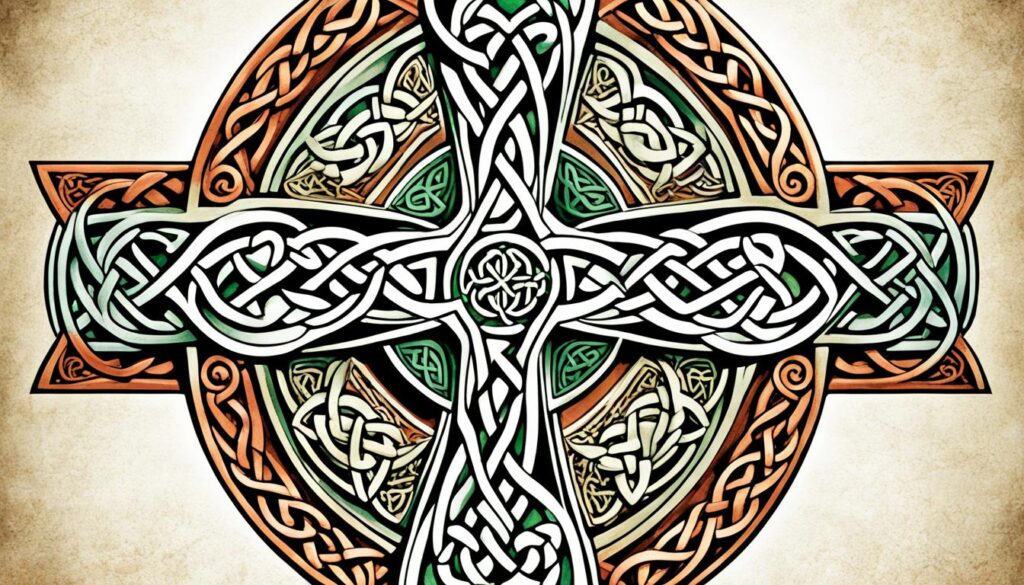 |
Representation of balance, spirituality, and the sun |
| Coptic Cross | 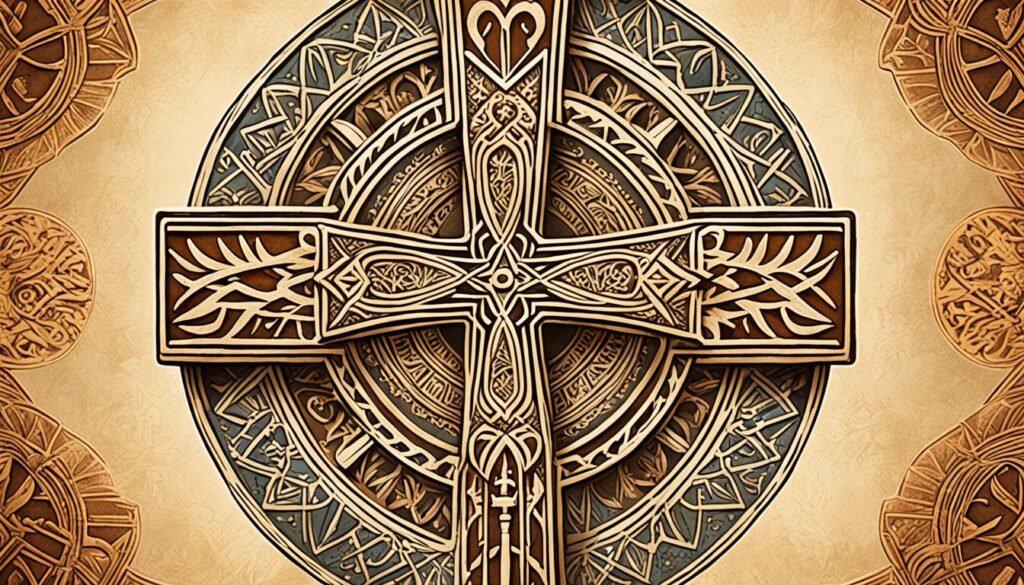 |
Unity of heaven and earth, eternal love |
The table above provides a concise summary of the three types of crosses discussed in this section, highlighting their designs and specific meanings. It is important to remember that while these crosses have cultural and religious associations, their symbolism may vary depending on individual interpretations and traditions.
Symbolism of Cross Variants
Variants of the cross, such as the Russian cross, Jerusalem cross, and Maltese cross, have their own distinct symbolism and cultural significance. Each cross variant carries unique meanings that are deeply rooted in specific religious and cultural contexts.
Russian Cross
The Russian cross, also known as the Orthodox cross, is a prominent symbol in Russian Orthodox Christianity. Its design features three horizontal bars, representing the inscription on the cross of Jesus, INRI. The Russian cross symbolizes the triumph of Christ over death and is a reminder of His sacrifice for humanity.
Jerusalem Cross
The Jerusalem cross, also known as the Crusader’s cross, is comprised of a central cross with four smaller crosses surrounding it. It is associated with the Christian kingdom of Jerusalem during the time of the Crusades. The Jerusalem cross symbolizes the Five Wounds of Christ and represents the spread of Christianity across the five continents.
Maltese Cross
The Maltese cross, also known as the eight-pointed cross, carries great significance in the Maltese culture and the Order of Malta. It is often associated with honor, courage, and nobility. The eight points of the cross represent the eight virtues of the Knights of Malta: loyalty, piety, honesty, dedication, humility, compassion, respect, and perseverance.
Understanding the symbolism of cross variants enables individuals to appreciate the rich cultural and religious heritage associated with each design. Each cross variant serves as a powerful reminder of faith, sacrifice, and the enduring values that have shaped civilizations throughout history.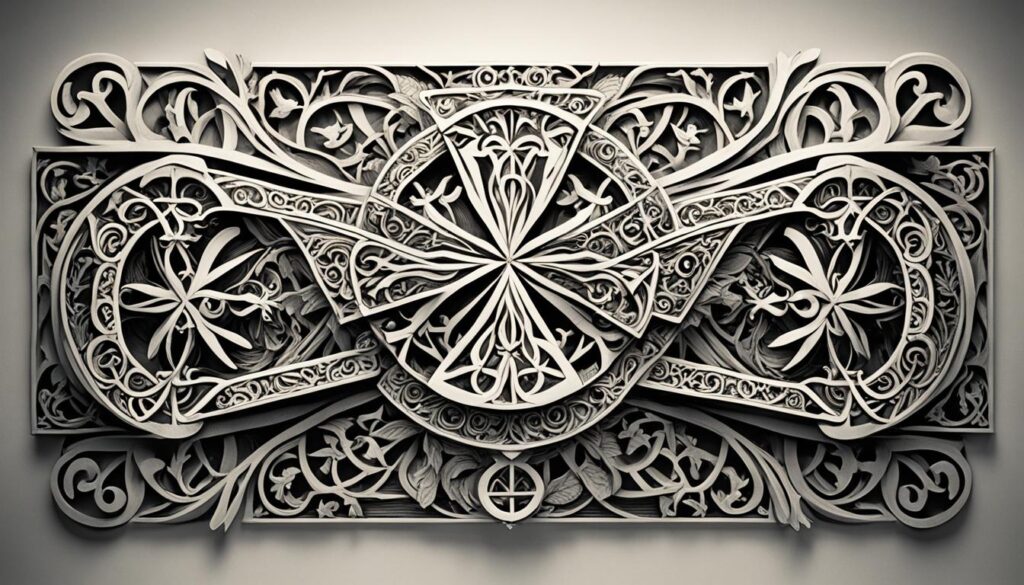
Crosses in Ancient History and Modern Culture
The cross holds a significant place in human history, dating back to ancient civilizations. One of the earliest examples of cross symbolism can be found in Egyptian hieroglyphs, where it is known as the “ankh” or “key of life.” This ancient symbol represented eternal life and was associated with the gods and goddesses of the Egyptian pantheon.
Throughout the centuries, the cross has continued to be a powerful and enduring symbol, transcending time and culture. Its historical significance is rooted in various civilizations and religious traditions, from ancient Egypt to Christianity and beyond.
In modern culture, the cross is still widely recognized and used in a variety of contexts. It remains a prominent religious symbol, representing faith, salvation, and resurrection. Churches and religious institutions often display crosses prominently as a visual representation of their beliefs.
Moreover, the cross has also found its place in fashion and popular culture. It is a popular motif in jewelry design, appearing in necklaces, bracelets, earrings, and rings. The cross’s aesthetic appeal, coupled with its historical and spiritual significance, makes it a timeless and versatile symbol that resonates with people across different walks of life.
“The cross, as a symbol, carries immense historical and spiritual weight. Its presence in ancient history and continued relevance in modern culture speak to its enduring power and symbolism.” – Crosses: An Exploration of Symbolism and Meaning
The Coptic Cross: A Testament of Faith and Identity
In Egypt, the Coptic cross holds special significance. It is a distinct variation of the cross symbol, characterized by its unique design and the presence of additional decorative elements. The Coptic cross is often associated with the Coptic Orthodox Church, one of the oldest Christian denominations in the world.
The Coptic cross serves as a testament of faith and identity for Coptic Christians in Egypt. It is commonly worn as a pendant, displayed in homes, and featured in Coptic artwork and architecture. The cross symbolizes the belief in Christ’s sacrifice and the hope of eternal life.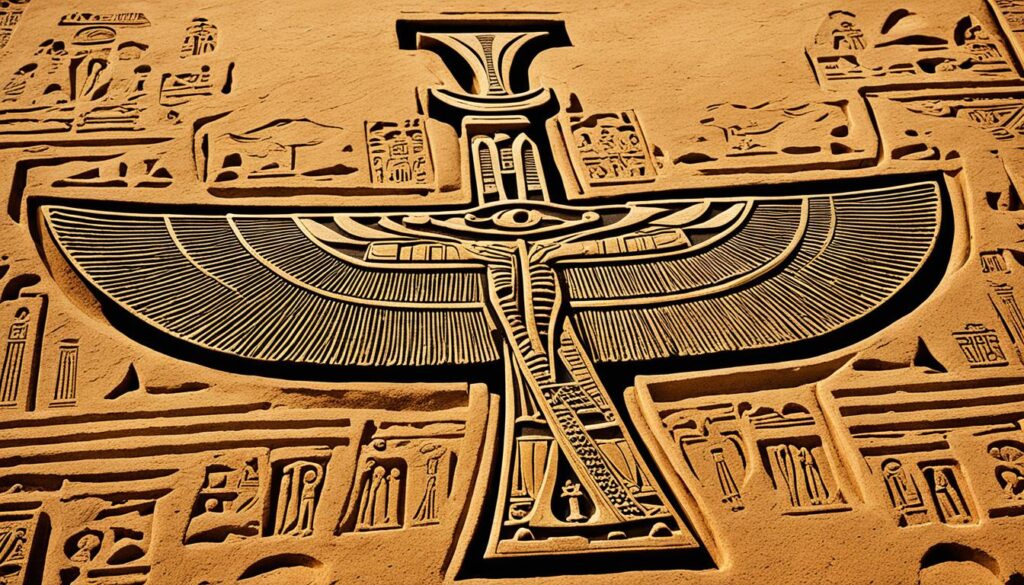
| Ancient History | Modern Culture |
|---|---|
| The cross has been found in ancient Egyptian hieroglyphs, representing the “ankh” or “key of life.” | The cross remains a prominent religious symbol, displayed in churches and worn as jewelry. |
| Ancient civilizations, such as Egypt, used the cross as a symbol of divinity and eternal life. | The cross is a popular motif in fashion, appearing in various forms of jewelry. |
| Crosses held different meanings across cultures, including spiritual, cosmic, and religious interpretations. | Popular culture embraces the cross as a symbol of faith, rebellion, and personal expression. |
Crosses as Personal and Religious Symbols
Crosses hold personal and religious significance for many individuals. They are not only symbols of faith but also carry deep meanings that resonate with people on a personal level. Whether worn as tattoos or pendants, crosses serve as powerful reminders of one’s beliefs and values.
The Meanings Behind Cross Tattoos
When it comes to cross tattoos, the meanings can vary depending on the individual and their cultural or religious background. For some, a cross tattoo represents their Christian faith and serves as a visual display of their commitment to their beliefs. Others may choose a cross tattoo to honor a loved one or symbolize personal growth and transformation. The design, size, and placement of the cross tattoo can also contribute to its unique significance.
“A cross tattoo serves as a daily reminder of my unwavering faith and the strength it gives me to navigate life’s challenges,” says Amanda, a devout Christian.
The Symbolism of Cross Pendants
Cross pendants are a popular form of religious jewelry, worn by people of different faiths around the world. These pendants often carry symbolic meanings that go beyond mere fashion accessories. In Christianity, the cross pendant is a representation of the sacrifice made by Jesus Christ and serves as a constant reminder of His love and redemption. For others, cross pendants may symbolize protection, guidance, or personal connection to a particular saint or religious figure.
“I wear my cross pendant every day as a symbol of my spirituality and as a source of strength and comfort,” shares Michael, a devout Catholic.
The Personal Significance of Crosses
Crosses hold personal significance for individuals on their respective faith and spiritual journeys. They can serve as a source of inspiration, a reminder of moral values, or a symbol of hope and resilience in challenging times. Regardless of religious affiliation, crosses often represent concepts such as love, forgiveness, and the pursuit of a higher purpose.
For many, the personal significance of crosses lies in their ability to offer solace and a sense of belonging. They can provide a connection with something greater than oneself and serve as a tangible representation of one’s relationship with the divine.
Ultimately, whether adorned as tattoos or worn as pendants, crosses carry deep meanings that are as unique as the individuals who cherish them. These symbols of faith and spirituality continue to inspire, comfort, and guide those who embrace their presence in their daily lives.
Crosses as Artistic and Decorative Elements
Crosses have long been revered as powerful symbols in Christian art and design. They are not only religious icons but also have deep cultural and spiritual meanings. These cross designs are often incorporated into various forms of art, including paintings, sculptures, stained glass windows, jewelry, and architectural details. The artistic rendering of crosses allows artists to convey Christian symbolism and evoke a sense of devotion, faith, and reverence.
In Christian art, different cross designs hold specific meanings and symbolize various aspects of the Christian faith. The most common cross design is the Latin cross, which consists of a vertical beam intersecting a shorter horizontal beam near the top. This design represents the crucifixion of Jesus Christ and is widely recognized as a symbol of Christianity. The simple yet profound shape of the Latin cross makes it a versatile symbol that can be easily incorporated into various art forms.
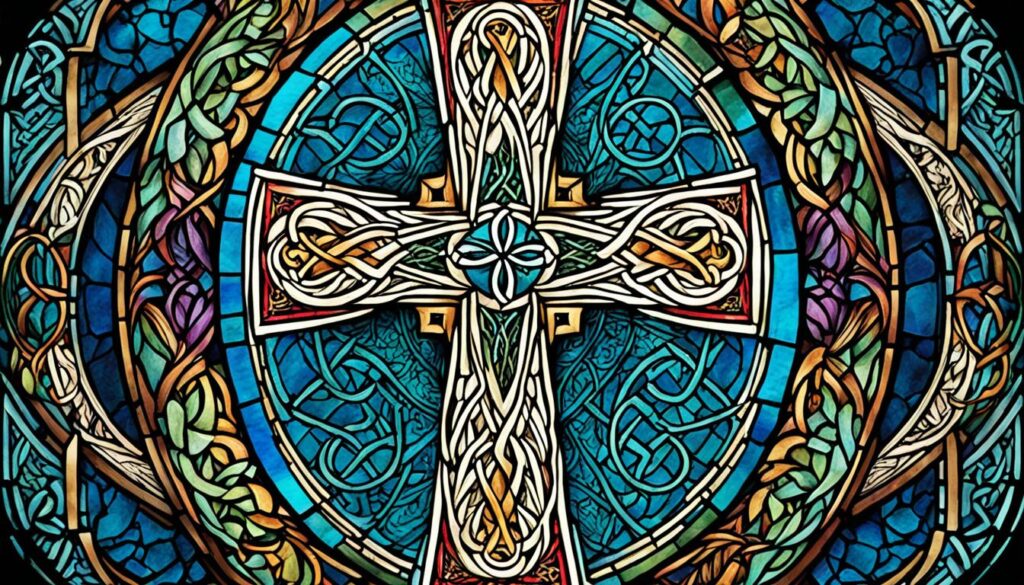
The use of crosses in Christian art goes beyond the traditional Latin cross. Various cross variants, such as the Celtic cross and the Byzantine cross, offer unique designs and additional layers of symbolism. The Celtic cross, with its distinctive circle intersecting the vertical and horizontal beams, represents eternity and the unification of heaven and earth. It is often associated with Celtic Christian traditions and can be seen in intricate stone carvings and illuminated manuscripts.
The Byzantine cross, also known as the Eastern Orthodox cross, has additional arms at the top and bottom, symbolizing the importance of faith in all directions and throughout all creation. This cross design is commonly found in Byzantine religious icons, mosaics, and decorative embellishments in Eastern Orthodox churches.
Christian art also explores the symbolism of crosses through unique artistic interpretations. Artists use color, texture, and composition to convey spiritual concepts and evoke emotional responses. The act of creating art with cross motifs can be seen as an act of devotion and a way to express faith visually.
“The cross is not only a symbol of suffering and sacrifice but also a symbol of hope, redemption, and salvation. It represents the unbreakable bond between God and humanity. Through art, we can explore the profound beauty and significance of the cross, inviting viewers to contemplate its spiritual meaning.”
Christian Symbolism in Cross Designs
Christian symbolism is inherent in cross designs in various ways. The vertical beam of the cross is associated with the divine realm and represents the connection between heaven and earth. It symbolizes God’s love for humanity and the divine presence in our world. The horizontal beam, on the other hand, represents the human realm and symbolizes the unity and reconciliation brought by Jesus Christ’s sacrifice. The intersection of the vertical and horizontal beams signifies the union of divinity and humanity, representing the core belief of Christianity.
Additionally, the cross’s shape and structure offer deeper symbolism. Its symmetry suggests balance and harmony, while the upward movement from the horizontal to the vertical beam signifies spiritual ascension. The cross also reflects themes of self-sacrifice, forgiveness, and the redemptive power of love.
Decorative Use of Crosses
Besides their symbolic significance, crosses are widely used as decorative elements in religious and cultural contexts. They can be found adorning churches, religious artifacts, personal altars, and even clothing and accessories. The ornate detailing and elaborate craftsmanship of cross designs enhance their aesthetic appeal and evoke a sense of reverence and adoration. Crosses can be seen in intricate stained glass windows, delicate engravings on chalices and ciboria, and beautifully crafted pendants and rosaries.
The use of crosses as decorative elements extends beyond religious contexts. They are often incorporated into interior design, fashion, and jewelry as a way to express one’s faith or appreciate the symbolism they represent. Crosses can be found in home decor items, fashion accessories such as necklaces and earrings, and even as tattoos, serving as personal reminders of one’s spirituality and connection to Christian beliefs.
Overall, crosses are not only religious symbols but also powerful artistic and decorative elements. Through different cross designs and their symbolism, artists and artisans continue to create and celebrate expressions of faith, beauty, and devotion across diverse artistic mediums.
Conclusion
In conclusion, the symbolism of crosses holds significant cultural and spiritual meaning transcending time and religious traditions. Crosses symbolize sacrifice, transcendence, humility, love, and heroism. Understanding the spiritual significance of crosses can deepen our understanding of religious symbolism and provide valuable insights into the diverse interpretations and reverence given to this powerful symbol across different cultures and religions.
Throughout history, crosses have been revered and interpreted in various ways, representing the ultimate sacrifice in Christianity and serving as a model for love and heroism. Crosses have been used to bridge the gap between the earthly plane and the realm of spirituality. They have also been embraced as personal symbols of faith and seen as decorative elements in various art forms.
Whether it’s the Latin cross, Celtic cross, Russian cross, or any other cross variant, each carries its own unique meaning and cultural significance. The cross has endured misconceptions and misinterpretations, but its true essence remains rooted in spiritual and religious symbolism.
By exploring the symbolism of crosses and their spiritual significance, we can gain a deeper appreciation for the profound impact this symbol has had on humanity throughout history and continue to honor its enduring presence in our modern culture.FAQ
What is the significance of crosses in different cultures and religions?
What are some popular types of crosses and their meanings?
What is the significance of cross variants like the Russian cross and Jerusalem cross?
How has the cross been used throughout history and in modern culture?
What do cross tattoos and cross pendants symbolize?
How are crosses used as artistic and decorative elements?
What are some misconceptions and misinterpretations of the cross?
Are Viking Symbols Related to Christian Crosses?
In the decoding Viking symbols tutorial, it is revealed that some Viking symbols are indeed related to Christian crosses. The intertwining of the two cultures can be seen in certain artifacts and carvings, indicating a blending of religious beliefs during the Viking Age.
Source Links
- https://medium.com/indian-thoughts/the-deeper-symbology-of-the-cross-de26eca1a0f2
- https://churchleaders.com/christianity/474544-petrine-cross-symbolism-history-impact.html
- https://www.faruzo.com/blog/different-types-of-crosses-and-their-meanings/
Vanice, Content Director – Vanice, armed with extensive knowledge in linguistics, oversees the curation of all content on What Does Meanings. She ensures that every article, video, and guide is informative, engaging, and accessible to audiences of all backgrounds. Her editorial direction keeps our content relevant and enlightening.

Cultural and Historical Symbols
The Comprehensive Guide to the Nalu Meaning
Peek into the profound world of the Nalu symbol, uncovering its ancient roots and modern significance, leaving you eager to delve deeper.

Explore the profound Nalu symbol rooted in ancient Hawaiian culture. It symbolizes the rhythmic dance of ocean waves, conveying tranquility, strength, and divine messages. Nalu embodies themes of interconnectedness and cyclical existence, highlighting a spiritual link between humans and the sea. In art, it signifies fluidity, movement, and harmony with nature. In daily life, Nalu guides us to find balance, resilience, and acceptance amidst challenges. Jewelry pieces inspired by Nalu echo inner strength and harmony. Nalu's impact spans generations, inspiring hope, balance, and tranquility. Its influence on fashion captures the calming essence of water. Discover deeper meanings by exploring the Nalu symbol.
Key Takeaways
- Nalu symbolizes ocean waves' dance and divine messages.
- Represents interconnectedness, strength, and tranquility.
- Nalu jewelry embodies inner strength and harmony.
- Art captures fluidity, movement, and nature's interconnectedness.
- Offers inspiration for balance, resilience, and harmony in life.
Origins of the Nalu Symbol
The origin story of the Nalu symbol traces back to ancient Hawaiian culture, where it emerged as a powerful representation of the rhythmic dance of ocean waves. Nalu embodies the essence of Hawaiian culture, where the name itself translates to 'wave' in the Hawaiian language.
Waves hold a significant place in Hawaiian traditions, symbolizing not just the physical motion of the ocean but also deeper meanings of tranquility and strength. In Hawaiian culture, waves are revered as divine messengers, believed to carry messages from the spirit world.
The symbolism of Nalu extends beyond just the physical domain, delving into spiritual spheres where it evokes a sense of serenity and interconnectedness with nature. This cultural significance of Nalu in Hawaiian culture highlights the deep respect and admiration that the Hawaiian people have for the ocean and its rhythmic waves.
Cultural Significance of Nalu

Nalu holds deep cultural significance across various traditions, embodying themes of interconnectedness and cyclical existence.
In Hawaiian culture, waves are revered as divine messengers, symbolizing the profound spiritual connection between humans and the sea.
Nalu rituals and symbolism reflect the enduring historical connection between people and the powerful forces of the ocean.
Nalu in Traditions
Embraced by diverse cultures worldwide, waves are revered as divine messengers in Hawaiian culture, symbolizing interconnectedness and conveying messages from the spirit world. In Hawaiian traditions, Nalu represents the cyclical nature of existence, reminding individuals of the rhythmic motion of ocean waves. It symbolizes tranquility, strength, and the essence of the sea, embodying a sense of serenity and conveying messages from the spirit world.
This cultural significance of Nalu extends beyond Hawaii, resonating with people globally. Understanding Nalu in traditions provides insight into the spiritual connections many cultures have with the ocean and the profound meanings they derive from its powerful waves. The reverence for Nalu reflects a deep appreciation for the natural world and its spiritual significance.
Nalu Symbolism
Exploring the cultural significance of Nalu reveals deep-rooted connections to spiritual domains and the cyclical essence of life across diverse traditions. In Hawaiian culture, waves are revered as divine messengers, conveying messages from the spirit world. Nalu symbolizes the interconnectedness of life and reminds individuals of the cyclical nature of existence. It extends to spiritual spheres, evoking serenity and connection to nature.
Nalu represents perpetual motion, serenity, and the cyclical nature of life across different cultural contexts. Embraced by various cultures, Nalu holds cultural significance in Hawaiian traditions. The symbolism of Nalu transcends borders, resonating with individuals worldwide as a symbol of harmony, balance, and the eternal flow of life.
Nalu Rituals
In understanding the cultural significance of Nalu rituals, we uncover profound connections to the essence of life and spiritual domains, particularly within Hawaiian traditions. Waves are revered as divine messengers, carrying messages from the spirit world. These rituals serve as reminders of the cyclical nature of existence, highlighting the ebb and flow of life.
The cultural importance of Nalu rituals transcends Hawaii, resonating with diverse cultures globally. Engaging in Nalu rituals fosters a spiritual connection, conveying messages from the sea and nature. This deep-rooted practice symbolizes the interconnectedness of life, offering insights into the mysteries of the universe and our place within it.
Nalu Symbolism in Art

Nalu symbolism in art captures the essence of ocean waves through various mediums like paintings, sculptures, and jewelry.
Artists use Nalu motifs to convey themes of fluidity, movement, harmony, and the cyclical nature of life.
Nalu-inspired artworks often evoke a sense of serenity, strength, and interconnectedness with nature.
Nalu in Visual Arts
With a nod to the ocean's elegance and strength, artists illuminate Nalu symbolism in their creations, capturing the essence of life's fluid rhythms. Nalu artworks often portray the graceful yet powerful nature of ocean waves, symbolizing themes of movement, harmony, and interconnectedness with nature.
Through Nalu-inspired pieces, artists aim to evoke a sense of tranquility and convey the cyclical nature of existence. These visual representations reflect the beauty of embracing life's currents and the ebb and flow of its rhythms.
Cultural Interpretations of Nalu
Through various cultural lenses, artists around the world interpret Nalu symbolism in their art, weaving together diverse narratives of interconnectedness and cyclical existence. Nalu art signifies the interwoven fabric of life and often conveys messages from the spirit world. It evokes a profound sense of serenity and spiritual interconnectedness, transcending geographical boundaries to be embraced by various cultures.
The art of Nalu captures both tranquility and strength, embodying the essence of life's rhythms. Artists use Nalu symbolism to depict the cyclical nature of existence, illustrating the interconnectedness of all things. This artistic expression serves as a visual reminder of the ever-changing yet harmonious balance within the universe, inviting viewers to contemplate the profound interconnectedness of life.
Nalu Meaning in Daily Life

Amidst life's unpredictable tides, we endeavor to maintain inner peace by embracing the philosophy of Nalu. Nalu meaning in daily life emphasizes finding balance amid chaos and staying rooted in calmness. It teaches us to harmonize our mind, body, and spirit to navigate challenges with grace.
By embracing Nalu's philosophy, individuals can ride the waves of existence, flowing with life's currents for holistic wellness. This concept guides us to accept the natural ups and downs, helping us adapt to changes gracefully. It encourages us to approach each day with a sense of tranquility, understanding that life's challenges are part of a greater journey.
Nalu serves as a reminder to stay mindful, grounded, and centered, enabling us to face obstacles with resilience and composure. Embracing Nalu in daily life fosters a sense of inner strength and harmony, allowing us to navigate life's complexities with grace and ease.
Nalu Representation in Jewelry

Exploring from the philosophy of Nalu in daily life, the Nalu jewelry collection offers elegant pieces that symbolize inner strength and harmony.
The collection includes a sterling silver bracelet and a cuff bracelet, both in size 7.5, along with a heart ring in gold with diamonds measuring 11.5mm, heart earrings in gold with diamonds measuring 12mm, and a pendant in white gold with diamonds measuring 15mm.
Prices range from $545 for the gold heart ring with diamonds to $855 for the white gold earrings with diamonds. Availability varies, with some items like the gold heart ring currently out of stock while others like the white gold pendant are readily available.
Each piece in the Nalu jewelry collection embodies the essence of Nalu, offering wearers a tangible way to carry the meaning of strength and harmony with them throughout their day.
Interpretations of Nalu Across Generations

Across different age groups, interpretations of Nalu's essence of fluidity and harmony vary greatly. Elderly individuals often view Nalu as a symbol of the wisdom gained from maneuvering life's challenges. They see it as a reminder of the continuous ebb and flow of existence, teaching them resilience and adaptability.
In contrast, younger generations embrace Nalu's philosophy as a guide to going with the flow and finding inner peace amidst life's uncertainties. They see Nalu as a beacon of hope, encouraging them to stay grounded and flexible in the face of change.
Nalu's metaphorical representation appeals to individuals of all ages seeking balance and tranquility in their lives, regardless of the stage of life they're in. This timeless symbol continues to resonate across generations, offering a source of inspiration and guidance for those who seek harmony and serenity in a world of constant motion.
Nalu's Influence on Fashion

Nalu's impact on fashion is evident through its elegant jewelry pieces inspired by the graceful movements of ocean waves. The Nalu collection includes stunning bracelets, cuff bracelets, rings, earrings, and pendants made from sterling silver and gold, featuring intricate diamond details. Each piece captures the essence of the sea, symbolizing tranquility, strength, and spiritual interconnectedness.
Nalu's fashion line aims to evoke serenity and a connection to nature through beautifully designed accessories, appealing to those who seek balance and harmony in life's cycles. The allure of Nalu's jewelry lies in its ability to embody the fluidity of the ocean and the calming influence of water, making it a popular choice for individuals looking to infuse their style with elements of nature.
Nalu's Impact on Modern Culture

In modern culture, the symbolism of Nalu's waves serves as a powerful connection to the essence of nature and the sea. The impact of Nalu on modern culture is profound, influencing various aspects of society:
- Spiritual Significance: Hawaiian culture views waves as divine messengers, symbolizing spiritual messages and the interconnectedness of life.
- Philosophical Alignment: Nalu's philosophy of embracing life's currents resonates with individuals seeking balance and harmony in today's fast-paced world.
- Aesthetic Representation: The Nalu collection beautifully captures the grace and beauty of Hawaiian waves, offering timeless pieces that symbolize perpetual motion and tranquility.
- Universal Interpretation: Nalu's presence in modern culture reflects a universal interpretation of finding strength and serenity in the cyclical nature of existence.
Through these lenses, Nalu's impact on modern culture extends beyond mere aesthetics, delving into deeper themes of spirituality, philosophy, and universal connections with nature.
Frequently Asked Questions
What Is the Meaning of Nalu?
Nalu means 'wave' in Hawaiian. It embodies fluidity, movement, and harmony. This word symbolizes life's ebb and flow, reflecting the rhythmic patterns of ocean waves.
Nalu represents a philosophy of going with the flow and embracing life's currents. It teaches us to navigate challenges by finding inner peace. Imagine being rooted in the stillness of the ocean floor, finding calm amidst chaos.
What Does Ka Nalu Mean?
Ka Nalu means 'the wave' or 'waves' in Hawaiian. It embodies power, grace, and movement, symbolizing the beauty of ocean waves.
This term reflects a deep connection to nature and the cyclical essence of life in Hawaiian culture. It also symbolizes the harmony between surfers and the ocean, capturing the spirit of surfing.
Conclusion
In the tapestry of culture, the Nalu symbol weaves a thread of significance that connects generations past and present. Its origins date back to ancient times, with meanings evolving yet maintaining its essence.
From art to jewelry, Nalu's influence is undeniable in various aspects of daily life. As fashion trends come and go, the Nalu symbol remains a timeless representation of tradition and heritage, leaving a lasting impact on modern culture for years to come.
Boaz, Founder and Chief Editor – With a profound linguistics and anthropology background, founded What Does Meanings to explore the intricate connections between language, symbols, and cultural identity. His vision has guided the platform from its inception, ensuring that each piece of content enriches our understanding of the world’s symbolic heritage.
Cultural and Historical Symbols
Exploring the Meaning of Pachinko
Peek into the world of Pachinko, where chance intertwines with culture, inviting you to unravel its deeper layers.

Pachinko, originating as a child's toy and evolving into a popular gambling game, symbolizes life's unpredictability and characters' pursuit of success amidst turbulence. The game, entwining chance, community, and resilience, extends a profound narrative beyond its mechanics. With deep roots in Korean and Japanese cultures, Pachinko's symbolism reflects themes of discrimination, resilience, and fate. Success in the game relies on a blend of skill and chance, making each play a thrilling mix. Exploring Pachinko's meaning uncovers a rich tapestry of cultural significance and societal reflection, hinting at a deeper narrative awaiting discovery.
Key Takeaways
- Pachinko embodies life's unpredictability and themes of resilience.
- It symbolizes fate and success in a turbulent world.
- Reflects on discrimination and cultural complexities in the Korean diaspora.
- Characters adapt to unpredictable situations in a dynamic environment.
- Gameplay involves a mix of skill and chance, navigating balls to win.
Historical Origins of Pachinko
Delving into the historical roots of Pachinko reveals its evolution from a simple children's toy to a popular gambling game post-World War II. Initially a Korean invention brought to Japan in the 1920s, Pachinko underwent a transformation that mirrored the societal shifts of the time. What began as an innocent pastime for children soon caught the attention of adults, leading to its adaptation into a thrilling gambling machine. The fusion of Korean origins with Japanese innovation birthed a new form of entertainment that resonated deeply with the post-war population.
As Pachinko shifted from a toy to a gambling game, it became intertwined with Japanese culture, reflecting the country's evolving preferences and technological advancements. The historical origins of Pachinko highlight how a simple concept can metamorphose into a cultural phenomenon, showcasing the intricate interplay between tradition and modernity in Japan.
Evolution Into a Gambling Game
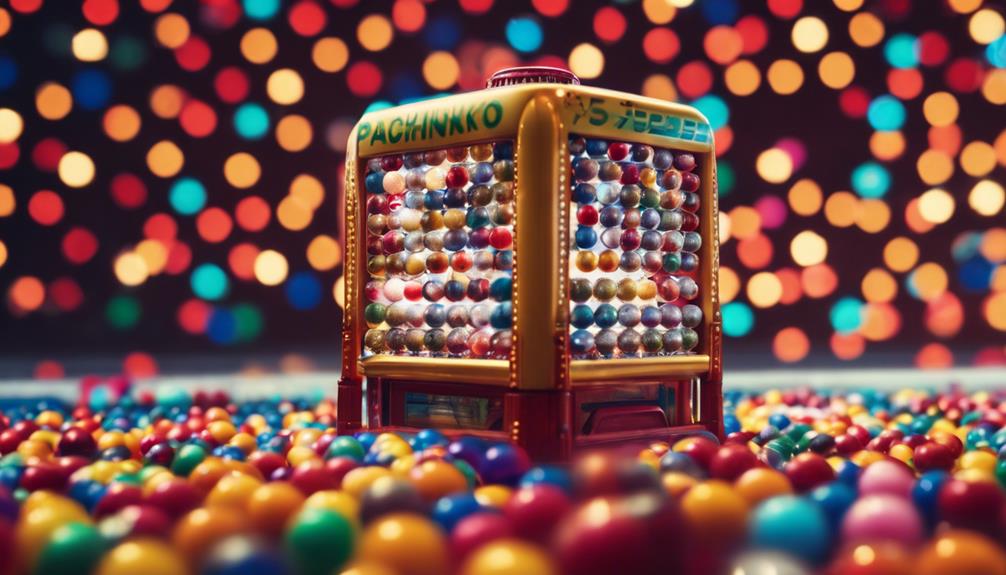
Pachinko underwent a significant metamorphosis from its origins as a children's toy in the 1920s to becoming a popular gambling game in Japan post-World War II. This shift mirrored societal changes and preferences over time. The evolution of Pachinko into a gambling game also integrated aspects of Korean Japanese culture, adding to its complexity and appeal. Pachinko parlors became prominent venues for gameplay, drawing in a diverse range of players and contributing to the game's widespread recognition in Japanese society.
As Pachinko transformed into a gambling game, it not only adapted to the evolving preferences of the Japanese populace but also reflected the changing dynamics within the country. The Korean Japanese influence on Pachinko added a unique cultural dimension to the game, further solidifying its place in Japanese culture. This transformation marked a significant turning point for Pachinko, shaping its identity and setting the stage for its continued popularity in Japan.
Technological Advancements in Pachinko

The progression of Pachinko from a traditional game to a modern gambling sensation paved the way for significant technological advancements in the 1960s. These innovations transformed Pachinko machines, making them more engaging for players. The inclusion of electronic components revolutionized gameplay, offering a more immersive experience. Digital displays, sound effects, and interactive elements became key features, attracting a broader audience to the game.
The technological advancements in Pachinko not only enhanced the gaming experience but also improved game mechanics, providing players with a more entertaining time. These developments reflected Japan's commitment to embracing technological progress and innovation in the gaming industry. The evolution of Pachinko machines showcased a shift towards more sophisticated gameplay features, aligning with the growing demand for a dynamic and engaging experience.
Pachinko's Popularity Surge

During the 1970s and 1980s, as Pachinko's popularity surged, it became a cultural phenomenon in Japan. The game's addictiveness and entertainment value captivated players, leading to its widespread appeal. Technological advancements in Pachinko machines further enhanced gameplay, attracting even more enthusiasts.
Pachinko parlors evolved into social hubs where players not only engaged in the game but also socialized with others, fostering a sense of community. The industry's profitability and significant economic impact solidified Pachinko's position as a major entertainment sector in Japan.
This surge in popularity not only cemented Pachinko as a beloved game but also contributed to the vibrant cultural landscape of Japan. The game's ability to bring people together and provide both entertainment and social interaction played an important role in its widespread recognition as a cultural phenomenon.
Understanding Pachinko Mechanics

Amid the intricate interplay of steel balls, pins, and cups, players engage in a delicate dance of skill and chance in the world of Pachinko mechanics. The Pachinko machine serves as the stage for this engaging gameplay, where players launch steel balls with precision and anticipation. The objective? To navigate these balls through the maze of pins and cups, aiming to hit winning pockets that lead to exciting prizes. This game, blending skill and chance, hinges on mastering the art of ball trajectory and understanding the machine's mechanics.
Success in Pachinko hinges on strategic gameplay. Players must analyze the layout of the machine, adjust their aim accordingly, and fine-tune their techniques to enhance their chances of winning. As steel balls cascade through the machine, each twist and turn presents a new challenge and opportunity. The thrill of the game lies in the balance between calculated skill and the unpredictable nature of chance, making each play an exhilarating experience.
Step-by-Step Guide to Playing Pachinko

Let's break down the key points of playing Pachinko:
- Understanding the rules
- Implementing winning strategies
- Grasping the mechanics of the machine
These aspects are essential in maneuvering the game successfully and maximizing your chances of accumulating balls or tokens for prizes.
Pachinko Rules Explained
Exploring the intricate layout of a pachinko machine, players launch small steel balls with precision and aim to strategically land them in winning pockets to trigger prizes.
Pachinko gameplay involves mastering the art of guiding the balls through a maze of pins and cups, aiming for ideal placement to maximize winnings.
As players accumulate balls, they can exchange them for various non-cash rewards based on the quantity collected during gameplay.
The regulation of pachinko operates within a legal grey area in Japan, adding complexity to both its gameplay and oversight.
Understanding the rules of play is essential for a successful pachinko experience, as it requires a blend of skill, strategy, and a bit of luck to achieve the desired outcomes.
Pachinko Winning Strategies
When playing Pachinko, we prioritize aiming for pockets that offer higher payouts and lower risks to maximize our ball collection efficiently. To excel, adjust the power and angle when launching balls to strategically target winning pockets.
Utilize features like the jackpot pocket and special bonuses to boost your chances of success. Developing a personalized playing style through practice and observing successful players is key to enhancing your gameplay skills in Pachinko.
Remember to exchange your won balls for prizes or tokens according to the rules of the Pachinko parlor. By focusing on these strategies and tailoring your approach to suit your style, you can increase your chances of winning and enjoy a more rewarding Pachinko experience.
Pachinko Machine Mechanics
Mastering the intricate maze of pins and cups inside a pachinko machine demands precision and strategy to maximize your winnings. When delving into the mechanics of a pachinko machine, consider these essential points:
- Understanding the physics of ball trajectory is key to maneuvering the pins effectively.
- Plan your launches strategically to target high-scoring pockets and increase your chances of winning big.
- Familiarize yourself with the machine's layout to adjust your gameplay and enhance your overall performance.
Exploring Pachinko as a Metaphor

Pachinko, as a metaphor, encapsulates the intricate dance between fate and chance in the characters' tumultuous lives in Min Jin Lee's novel. The game serves as a powerful symbol of life's uncertainties, mirroring the characters' struggles and successes. Just like in Pachinko, where players navigate risks and rewards, the characters in the novel face challenges influenced by fate and chance. The title itself, 'Pachinko', reflects the characters' journey marked by both triumphs and setbacks, echoing life's unpredictable nature.
Through Pachinko, Min Jin Lee illustrates how individuals respond to the twists of fate and the capriciousness of chance. The game's mechanics of risk-taking and perseverance parallel the characters' pursuit of success in a turbulent world. Life's compromises, tragedies, and uncertainties find resonance in the game, highlighting the characters' resilience in the face of adversity. Ultimately, 'Pachinko' symbolizes the essence of life as a gamble, where each spin of fate can lead to unexpected outcomes.
Symbolism in Pachinko

In exploring the symbolism in Pachinko, we uncover the intricate layers of meaning that enrich the characters' tumultuous journeys in Min Jin Lee's novel. Pachinko serves as a powerful symbol in the narrative, reflecting deeper themes of fate, luck, and the characters' struggles in a world filled with uncertainty. Through the lens of this game, readers witness the characters' relentless pursuit of success amidst a turbulent and unpredictable environment. The symbolism of Pachinko not only mirrors the characters' journeys but also highlights the complexities of life's twists and turns, where chance and perseverance intertwine to shape their destinies.
- Pachinko symbolizes the unpredictability of life, evoking a sense of unease and anticipation.
- The game represents the characters' relentless struggle against the odds, resonating with themes of resilience and determination.
- Pachinko acts as a metaphor for fate, underscoring the characters' unwavering quest for a better future despite facing numerous setbacks.
Pachinko's Societal Reflection
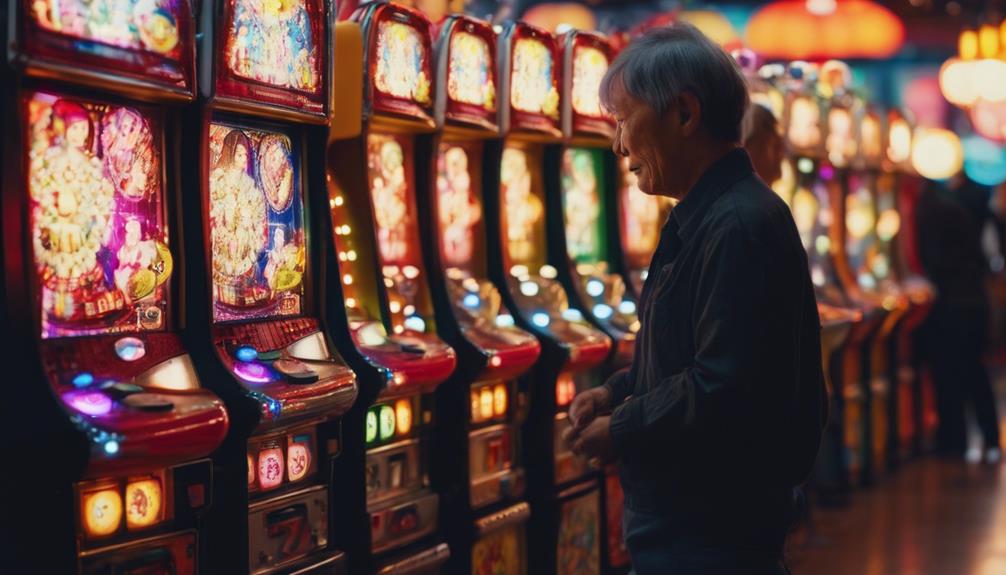
Reflecting the Korean diaspora in Japan, Pachinko sheds light on themes of discrimination and cultural complexities. The novel explores the challenges faced by Koreans living in Japan, showcasing their struggles for acceptance and belonging in a society that often marginalizes them. Through the characters' experiences, Pachinko illuminates the harsh realities of discrimination and the intricate layers of cultural identity that shape their lives.
Pachinko serves as a poignant societal reflection, drawing parallels between the characters' journeys and the broader issues of prejudice and cultural assimilation. By examining the Korean diaspora's narrative within the Japanese context, the novel prompts readers to reflect on the complexities of identity, belonging, and the impact of societal norms on individual lives.
Fate and Chance in Pachinko

Exploring the intricate interplay between fate and chance, characters in 'Pachinko' navigate through life's uncertainties and make decisions that shape their destinies. In the novel, the concept of fate isn't just predetermined but intertwined with the randomness of chance, creating a dynamic environment where characters must adapt and make choices that impact their lives profoundly. As the characters face unpredictable situations, they must confront the duality of fate and chance, leading to moments of tension and revelation throughout their journeys.
Characters in 'Pachinko' face pivotal moments where fate and chance collide, testing their resilience and determination.
Uncertainties in the characters' lives mirror the unpredictability of the Pachinko game, highlighting the fragility of their destinies.
The interplay between fate and chance adds layers of complexity to the characters' narratives, illustrating the intricate balance between choice and destiny in their lives.
Frequently Asked Questions
What Is the Message of Pachinko?
When considering the message of Pachinko, we see a profound exploration of fate, resilience, and the impact of life's uncertainties.
The novel uses this popular Japanese game as a powerful metaphor for the characters' struggles and ambitions. Pachinko symbolizes the Korean diaspora in Japan and explores intricate cultural dynamics.
Through the lens of this game, the story reflects society's risks, perseverance, and the universal pursuit of success.
What Is the Symbolism of Pachinko?
Pachinko's symbolism lies in its representation of fate and chance, mirroring life's uncertainties. It serves as a metaphor for risk and perseverance, highlighting themes of struggle and aspiration.
Just as the game reflects society's complexities, characters in the novel navigate challenges akin to Pachinko's unpredictable nature.
Pachinko symbolizes luck, fate, and the relentless pursuit of success amidst a turbulent world, drawing readers into a narrative rich with cultural dynamics and human resilience.
What Does Pachinko Teach Us?
Pachinko offers insights into resilience, acceptance, and the unpredictable nature of life. It showcases how individuals navigate fate and chance in a turbulent world. Through its portrayal, we gain a deeper appreciation for the complexities of cultural dynamics and discrimination.
The game's mechanics mirror characters' struggles and aspirations, highlighting parallels with real-life compromises and tragedies. Pachinko provides a profound lens to explore themes of belonging, acceptance, and the pursuit of success amidst adversity.
What Is the Meaning of Pachinko?
The meaning of Pachinko lies in its reflection of fate and chance, echoing our struggles and aspirations. This game mirrors themes of risk, perseverance, and the pursuit of success in a turbulent world.
It serves as a metaphor for life's uncertainties, drawing parallels between compromises and unpredictability. Exploring the Korean diaspora in Japan, discrimination, and cultural dynamics, Pachinko's name, from the sound of balls bouncing off pins, holds profound significance, symbolizing its influence and impact.
Conclusion
To sum up, pachinko, a game rooted in chance and fate, has evolved into a popular form of entertainment in Japan. Despite its simple mechanics, pachinko holds deep symbolism and reflects societal values.
The irony lies in the fact that a game based on luck can hold such significance in a culture known for its precision and hard work. Pachinko remains a fascinating window into Japanese society, blending tradition with modernity in unexpected ways.
Boaz, Founder and Chief Editor – With a profound linguistics and anthropology background, founded What Does Meanings to explore the intricate connections between language, symbols, and cultural identity. His vision has guided the platform from its inception, ensuring that each piece of content enriches our understanding of the world’s symbolic heritage.
Cultural and Historical Symbols
What Does 'Sounds of Silence' Mean?
Unravel the haunting beauty of "Sounds of Silence" by Simon & Garfunkel as it delves into societal disconnection and the power of speaking out against injustice.

'Sounds of Silence' by Simon & Garfunkel explores societal disconnection, the impact of staying silent amid injustice, and the longing for genuine human bonds. The song critiques modern communication struggles and the dangers of apathy, urging listeners to speak out against wrongs. Infused with symbolic references to urban loneliness, it warns against superficial interactions and encourages meaningful dialogue. The powerful message resonates through generations, emphasizing the importance of authentic connections in a world plagued by detachment. To fully understand the depth of its themes and symbolism, explore the song's evolution and legacy.
Key Takeaways
- Critiques societal disconnect and apathy.
- Symbolizes the lack of meaningful communication.
- Warns against the dangers of remaining silent.
- Reflects on the hollowness and alienation in modern society.
- Encourages speaking out against injustice.
The Origins of the Song
In our exploration of 'The Origins of the Song' for 'Sounds of Silence,' we unravel the intimate moment when Paul Simon, at the tender age of 21, penned this iconic piece amidst solitude and darkness.
Initially, 'The Sound of Silence' faced a setback, as it was a commercial failure on the duo's debut album. However, producer Tom Wilson saw its potential and decided to give it a new life. Wilson reimagined the song with drums and electric guitars, creating a rearranged version that resonated with a wider audience. This bold move led to immediate success, propelling the song to become an international hit in 1965.
Despite its humble beginnings, the triumph of 'The Sound of Silence' was a pivotal moment for Paul Simon and Art Garfunkel. The success of this song marked a turning point in their careers, prompting the regrouping of Simon & Garfunkel. Through perseverance and innovation, they transformed a moment of darkness and solitude into a shining example of musical brilliance.
Symbolism and Themes Explored

Exploring the symbolism and themes in 'The Sound of Silence' reveals a poignant commentary on communication breakdown and societal disconnection. The song investigates the consequences of apathy, societal ignorance, and the prevalence of superficiality in our interactions. It serves as a stark reminder of the lack of genuine connection in modern society, emphasizing the hollowness and alienation that many individuals experience.
Symbolism such as crowded city streets and neon lights underscore the themes of isolation and disconnection, painting a vivid picture of the world the lyrics describe. Additionally, 'The Sound of Silence' critiques mindless consumerism, a theme that remains as relevant today as it did over 50 years ago when the song was first released.
Through its powerful lyrics and evocative imagery, the song prompts listeners to reflect on the impact of these societal issues and the importance of meaningful communication and connection in a world increasingly characterized by noise and emptiness.
Decoding the Lyrics
When it comes to 'The Sound of Silence' lyrics, we need to pay attention to interpreting the messages hidden within the words.
The symbolism in the song and the profound message behind the silence are key elements to unravel.
Interpreting the Lyrics
Upon decoding the lyrics of 'The Sound of Silence,' one uncovers a poignant critique of societal disconnect and the consequences of apathy and superficiality. The song eloquently portrays the dangers of indifference and the need for genuine connection in modern society.
The following points emphasize the key themes within the lyrics:
- Silence as a barrier to effective communication.
- Apathy leading to societal ignorance.
- Superficiality hindering meaningful connections.
'The Sound of Silence' serves as a stark reminder of the importance of breaking through these barriers to truly understand and connect with one another. It warns against the perils of remaining silent in the face of injustice and the emptiness that can result from a lack of authentic interaction.
Symbolism in Song
Symbolism in 'The Sound of Silence' reveals the stark isolation and disconnection prevalent in modern society, depicted through vivid imagery of crowded city streets and neon lights. The lyrics convey a deep reflection on communication breakdown, societal apathy, and ignorance, critiquing the superficial interactions and lack of genuine connections that characterize our daily lives.
This symbolism serves as a poignant reminder of the isolation and disconnection many individuals feel in a world dominated by consumerism and materialistic values. Through the song, the artist warns against the dangers of prioritizing material possessions over meaningful human connections, highlighting the importance of authentic communication in a society plagued by superficiality.
'The Sound of Silence' remains a powerful commentary on the struggles of modern existence, urging listeners to seek deeper, more meaningful interactions.
Message Behind Silence
Exploring the lyrics of 'The Sound of Silence' reveals a profound commentary on communication breakdown, societal apathy, and the emptiness of modern interactions.
- The song critiques shallow interactions that lack genuine connections.
- It emphasizes the importance of speaking out against injustice and societal ignorance.
- 'The Sound of Silence' warns about the dangers of remaining silent in the face of issues, advocating for authentic communication.
These lyrics serve as a powerful reminder of the need for genuine human connection and the perils of staying silent in the face of injustice.
The song's profound meaning resonates with many, urging listeners to reflect on their own communication habits and the impact of remaining passive in times of societal turmoil.
Impact on Social Commentary

The impactful social commentary in 'The Sound of Silence' sheds light on the societal issues of communication breakdown and alienation. It serves as a powerful reminder of the consequences of shallow interactions and the importance of advocating for justice.
The symbolism in the song resonates with listeners, urging us to reflect on the emptiness in modern society and endeavor for genuine connections.
Social Critique Through Art
Through art, we can provoke societal reflection and challenge norms, as exemplified by the impactful social critique in 'The Sound of Silence' by Simon & Garfunkel.
- The song critiques societal silence, communication breakdown, and apathy.
- It emphasizes the importance of genuine connections and highlights the emptiness in modern interactions.
- The lyrics warn against the dangers of consumerism, superficiality, and indifference in society.
This masterpiece reflects the turbulent times of the mid-60s, stressing authentic communication and mirroring the collective consciousness of an era. 'The Sound of Silence' resonates with themes of alienation and disconnection, urging listeners to ponder the value of meaningful human connections in a world often overshadowed by noise and superficial interactions.
Symbolism in Society
In dissecting the societal commentary of 'The Sound of Silence,' we uncover profound symbolism that mirrors contemporary themes of disconnection and artificiality. The song symbolizes a communication breakdown and societal ignorance, highlighting modern society's superficial interactions and lack of genuine connections. It critiques the discontent, isolation, and artificiality prevalent in today's industrialized world, shedding light on issues like consumerism and alienation. The themes of alienation and disconnection resonate with audiences, making it a timeless commentary on society. Below is a table illustrating how the song's symbolism reflects various societal aspects:
| Symbolism in 'The Sound of Silence' | Contemporary Society |
|---|---|
| Communication breakdown | Superficial interactions |
| Discontent | Artificiality |
| Isolation | Consumerism |
The Evolution of the Music

How did the acoustic version of 'The Sound of Silence' transform into a global sensation? Initially, the acoustic rendition of the song struggled to gain attention. However, producer Tom Wilson's innovative decision to incorporate drums and electric guitars breathed new life into the music, resulting in a powerful and enchanting version that resonated with audiences worldwide. This transformation marked a turning point for the song, propelling it to immediate international success and paving the way for its enduring classic status.
- The acoustic version faced initial challenges in gaining popularity.
- Producer Tom Wilson's inclusion of drums and electric guitars revolutionized the song.
- The rearranged version of 'The Sound of Silence' quickly became a global hit.
The evolution of the music not only elevated the song to new heights but also played a pivotal role in reuniting Simon & Garfunkel, showcasing the profound impact music can have on artists and listeners alike.
Cultural Relevance Today

Reflecting contemporary struggles, 'The Sound of Silence' maintains its cultural relevance today by serving as a poignant anthem of perseverance and resilience amidst the challenges of the pandemic. In a world where people are facing unprecedented levels of silence in their careers and personal lives, this song's timeless words resonate deeply. It offers hope and encouragement, reminding individuals not to lose faith during tough times. The lyrics convey a message of resilience, emphasizing the importance of staying strong and patient in the pursuit of success.
With its melancholic melody and powerful words, 'The Sound of Silence' evokes emotions that inspire listeners to endure through difficult circumstances. Its impact goes beyond just a song; it symbolizes the strength found in resilience and serves as a beacon of hope for those experiencing silence in various aspects of their lives. As we navigate the challenges brought by the pandemic, this song continues to provide solace and motivation, making it a significant cultural touchstone for many.
The Power of Silence

Silence possesses a quiet strength, offering solace in times of turmoil.
Embracing moments of quiet contemplation can provide clarity and peace amidst life's chaos.
In a world filled with noise, silence can serve as a refuge for the mind and soul.
Silent Strength Within
Embracing the quiet strength found within the depths of stillness reveals a profound resilience and self-awareness. When we tap into this silent power, we reveal a wealth of benefits:
- Enhanced introspection: Silence allows us to explore deep within ourselves, fostering a heightened sense of self-awareness and understanding.
- Increased emotional fortitude: Through moments of quiet reflection, we build inner strength to face life's challenges with grace and resilience.
- Facilitates personal growth: Embracing silence nurtures personal development, enabling us to evolve and grow on our journey towards self-discovery.
Embracing Quiet Contemplation
In discovering the silent strength within, we uncover a profound reservoir of resilience and self-awareness. Embracing solitude and quiet contemplation allows us to engage in deep self-reflection, tapping into the power of silence to find inner peace.
By disconnecting from the noise of the world, we create space for contemplation and introspection, enabling us to explore our thoughts and emotions with clarity. The act of seeking moments of quietude fosters a sense of calm and understanding, offering a path to self-discovery and personal growth.
Through intentional introspection, we can cultivate a heightened awareness of ourselves and our surroundings, nurturing a harmonious balance between the external and internal worlds.
Silence as Refuge
Amid the chaos and clamor of the world, finding solace in moments of quiet reflection can offer a sanctuary for the mind and spirit. Silence serves as a refuge for introspection, allowing individuals to explore deeply into their thoughts and emotions.
Contemplation in silence can nurture a sense of strength, providing a space for individuals to gather their thoughts and find clarity amidst confusion. In the tranquility of silence, one can discover solace and peace, creating a haven away from the noise of the external world.
Through moments of silence, individuals embark on a journey of self-discovery, unraveling layers of their being and connecting with their innermost thoughts and feelings.
Influences on Popular Culture

Delving into the world of popular culture, we explore the profound impact of 'The Sound of Silence' on music and media. Originally released by Columbia Records, this iconic song has left a lasting imprint on the music industry. Its inclusion in the film 'The Graduate' and appearance on the soundtrack album further solidified its status as a classic folk rock anthem. The song's widespread popularity is evident in its top-ten chart positions in various countries, demonstrating its enduring appeal.
In 1972, 'The Sound of Silence' was featured on 'Simon and Garfunkel's Greatest Hits,' marking its inclusion in compilations that celebrate the duo's musical legacy. The National Recording Registry recognized the song's cultural significance in 2012, honoring it for its lasting impact on society. Additionally, Disturbed's cover version of 'The Sound of Silence' has garnered attention and chart success, highlighting the song's ability to resonate with audiences across different generations. This song continues to influence popular culture, showcasing its timeless relevance in the music industry.
Legacy and Continued Influence

Exploring the enduring legacy and continued influence of 'The Sound of Silence' reveals its profound impact on music and popular culture. The song has left an indelible mark on the music industry and beyond, shaping the way we perceive and interact with art.
Some key points to take into account are:
- 'The Sound of Silence' continues to be recognized in various accolades and hall of fames for its enduring impact.
- The song has been extensively used in popular culture, films, and covered by numerous artists, showcasing its continued influence.
- Allusions and parodies of 'The Sound of Silence' can be found in music and television, illustrating its lasting legacy.
The cultural significance of this iconic piece can't be overstated, as it has inspired countless artists and resonated with audiences across generations. The references to the song in various media platforms highlight its enduring relevance and timeless appeal.
From its original release to modern-day covers, 'The Sound of Silence' remains a demonstration of the power of music to transcend time and connect people through shared experiences.
Interpreting Personal Connection

In exploring the personal connection to 'The Sound of Silence', one can witness the profound impact it has on individuals maneuvering through challenges and uncertainties in their lives. This connection stems from the song's ability to resonate deeply with those experiencing feelings of loneliness, isolation, and the struggles of effective communication. Many listeners find solace and comfort in the lyrics, drawing inspiration and motivation during tough times. 'Sounds of Silence' prompts self-reflection, encouraging individuals to find hope and perseverance within themselves. Through its message of resilience, the song serves as a companion for those managing silence or setbacks.
| Keywords | Description |
|---|---|
| Personal Connection | Reflects how individuals relate to the song on a personal level |
| Resonate | The ability of the song to evoke strong emotions and thoughts within the listener |
| Solace | The comfort and relief that the song provides during difficult times |
In times of uncertainty, 'The Sound of Silence' offers a beacon of light, reminding us of the strength found in introspection and perseverance.
Frequently Asked Questions
What Is the Meaning Behind Sound of Silence?
The meaning behind 'The Sound of Silence' explores themes of loneliness, disconnect, and the consequences of societal silence. It criticizes shallow communication, societal indifference, and cautions against the dangers of consumerism.
The song highlights the significance of genuine connections and authentic communication in a modern world. It acts as a commentary on communication challenges and the need to break free from silence and apathy.
What Do Those Line From the Sound of Silence Mean?
Those lines from 'The Sound of Silence' carry profound meanings about solitude, disconnection, and the struggles of effective communication. They shed light on the challenges of showing one's true self and the fear of societal judgment.
The lyrics urge us to break free from superficiality, consumerism, and passivity in the face of injustice. They call for genuine connections, unity, and the courage to speak out against societal apathy.
What Does the Sound of Silence Mean in Christianity?
In Christianity, the 'Sound of Silence' signifies the act of listening to God's voice in moments of quiet reflection. It symbolizes a deep connection to the divine, emphasizing reverence, humility, and openness to divine guidance.
Christians often use silence as a tool for prayer, meditation, and seeking inner peace. This practice reflects the belief that stillness and reflection are essential for strengthening one's relationship with God and gaining spiritual clarity.
What Does the Words of the Prophets Are Written on the Subway Walls Mean?
We interpret 'the words of the prophets are written on the subway walls' as a powerful reminder to seek wisdom in unexpected places.
This line urges us to explore beyond the obvious and investigate the overlooked spaces of our lives for profound insights.
It suggests that valuable messages and guidance can be found in the most unconventional places, encouraging us to investigate and discover hidden truths in the ordinary.
Conclusion
To sum up, the 'Sounds of Silence' is a timeless song that explores profound themes and symbolism. Its impact on social commentary and influence on popular culture is undeniable.
The power of silence in the music and lyrics continues to resonate with listeners, creating a personal connection that transcends time.
As we reflect on the legacy and continued influence of this iconic song, we're reminded of the profound beauty found in the sounds of silence.
Vanice, Content Director – Vanice, armed with extensive knowledge in linguistics, oversees the curation of all content on What Does Meanings. She ensures that every article, video, and guide is informative, engaging, and accessible to audiences of all backgrounds. Her editorial direction keeps our content relevant and enlightening.
-

 Modern Symbols and Signs4 weeks ago
Modern Symbols and Signs4 weeks agoSubaru's Dashboard Symbols Unraveled: 10 Meanings
-

 Modern Symbols and Signs1 month ago
Modern Symbols and Signs1 month agoIs Five Guys Closing Permanently? The True Story
-

 Spiritual and Esoteric Meanings1 month ago
Spiritual and Esoteric Meanings1 month agoUnveiling Bird Poop on Car Spiritual Meaning
-

 Modern Symbols and Signs1 month ago
Modern Symbols and Signs1 month agoUnderstanding Innovatively Meaning – Dive In!
-

 Spiritual and Esoteric Meanings1 month ago
Spiritual and Esoteric Meanings1 month agoWedding Dream Meaning Death: Unveiling Symbols
-

 Linguistic Features and Figurative Language4 weeks ago
Linguistic Features and Figurative Language4 weeks agoDecoding Figurative Language: Understanding Rhetorical Devices
-

 Artistic and Decorative Symbols1 month ago
Artistic and Decorative Symbols1 month agoUnderstanding pp Mean on Sheet Music Dynamics
-

 Spiritual and Esoteric Meanings4 weeks ago
Spiritual and Esoteric Meanings4 weeks agoUnveiling the Meaning of 111 in the Bible

















